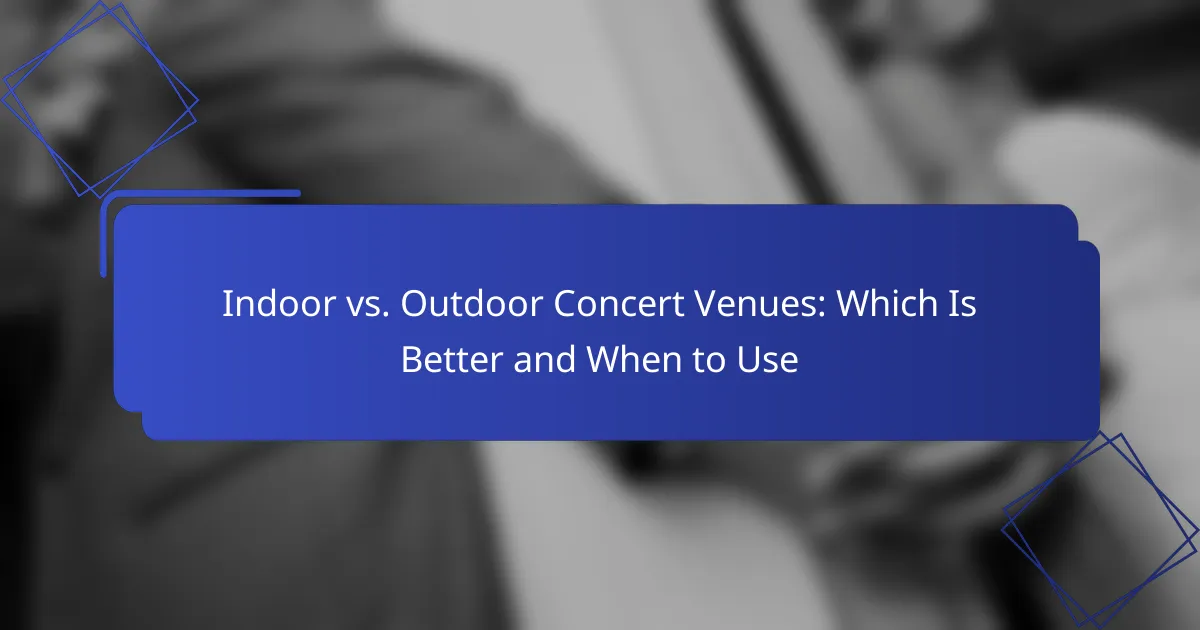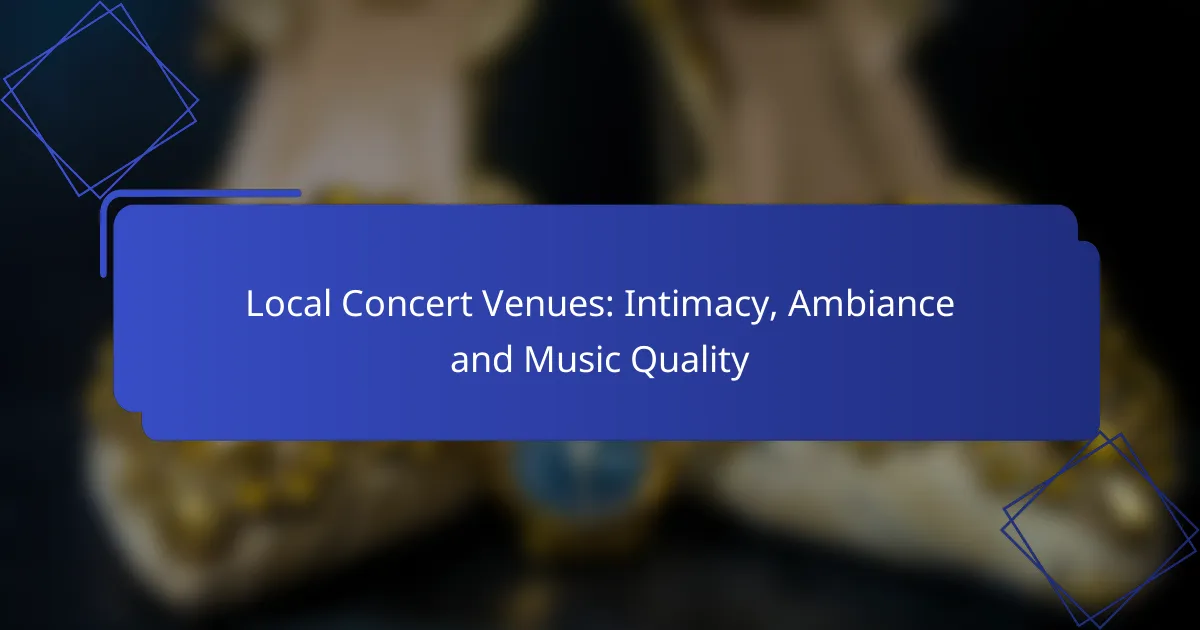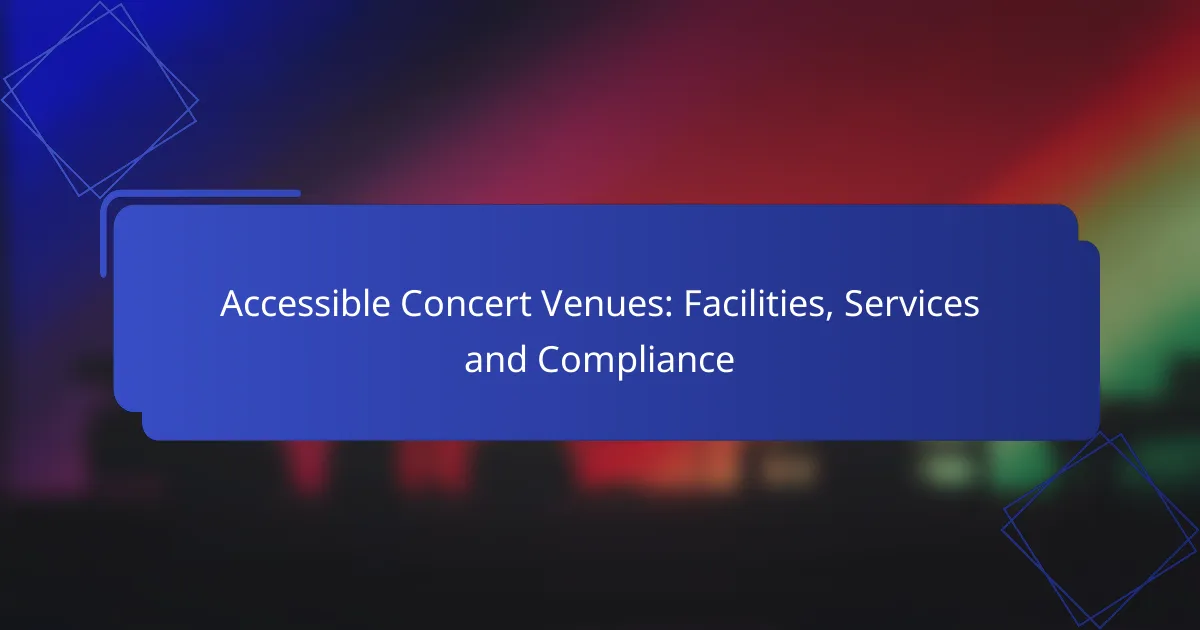When choosing a concert venue, several key factors come into play, including capacity, location, and acoustic quality. The atmosphere created by elements like lighting and seating arrangements can greatly enhance the audience’s experience. Additionally, accessibility and venue reputation are crucial for ensuring that both performers and attendees enjoy a memorable event.

How to choose the best concert venues in New York City
Selecting the best concert venues in New York City involves considering factors such as capacity, location, acoustic quality, and overall atmosphere. Each aspect plays a crucial role in ensuring a memorable experience for both performers and attendees.
Capacity and layout considerations
When choosing a concert venue, capacity is vital as it determines how many attendees can enjoy the performance. Venues in New York City can range from intimate spaces with a few hundred seats to large arenas accommodating thousands. Consider the type of concert and the expected audience size to select a venue that balances comfort and energy.
The layout of the venue also impacts the experience. Look for venues with good sightlines and accessible seating arrangements. A well-designed layout enhances audience engagement and ensures everyone can enjoy the performance without obstruction.
Location and accessibility factors
The location of a concert venue significantly affects attendance. Venues situated near public transportation, such as subway stations and bus routes, are more accessible for concertgoers. Consider venues in neighborhoods with ample parking options and nearby amenities like restaurants and hotels.
Accessibility for individuals with disabilities is another critical factor. Ensure the venue complies with the Americans with Disabilities Act (ADA) standards, providing features such as wheelchair ramps, accessible seating, and restrooms. This inclusivity enhances the overall concert experience for all attendees.
Acoustic quality and sound systems
Acoustic quality is essential for a successful concert. Venues should have sound systems that deliver clear audio without distortion. Research venues known for their excellent acoustics, as this can significantly impact the performance’s quality.
Consider the type of music being performed when evaluating sound systems. Some venues may excel in specific genres, such as rock or classical, due to their design and equipment. Attending a few concerts at potential venues can help gauge their acoustic capabilities firsthand.
Atmosphere and audience experience
The atmosphere of a concert venue contributes to the overall audience experience. Look for venues that offer a unique ambiance, whether it’s an intimate club or a grand theater. The right atmosphere can enhance the emotional connection between the audience and the performers.
Engagement opportunities, such as meet-and-greet sessions or interactive elements, can also elevate the experience. Venues that foster a sense of community and excitement often leave lasting impressions on concertgoers, encouraging repeat visits.

What are the key selection criteria for concert venues?
Key selection criteria for concert venues include venue reputation, technical specifications, and amenities. These factors significantly influence the overall experience for both performers and attendees, impacting everything from sound quality to accessibility.
Venue reputation and past performances
The reputation of a concert venue is often shaped by its history of hosting successful events and the caliber of artists it attracts. Venues known for high-profile performances typically draw larger crowds and can enhance the overall experience for attendees.
When evaluating a venue’s reputation, consider checking reviews, artist testimonials, and social media feedback. A venue with a strong track record of successful events is likely to provide a better experience in terms of sound quality, crowd management, and overall atmosphere.
Technical specifications and amenities
Technical specifications include sound systems, lighting, and stage design, which are crucial for delivering a high-quality concert experience. Venues should meet industry standards for acoustics and have the necessary equipment to support various types of performances.
Amenities such as seating capacity, accessibility features, and restroom facilities also play a vital role. Ensure the venue can accommodate the expected audience size comfortably and offers accessible options for individuals with disabilities. For instance, venues should ideally have wheelchair access and designated seating areas.
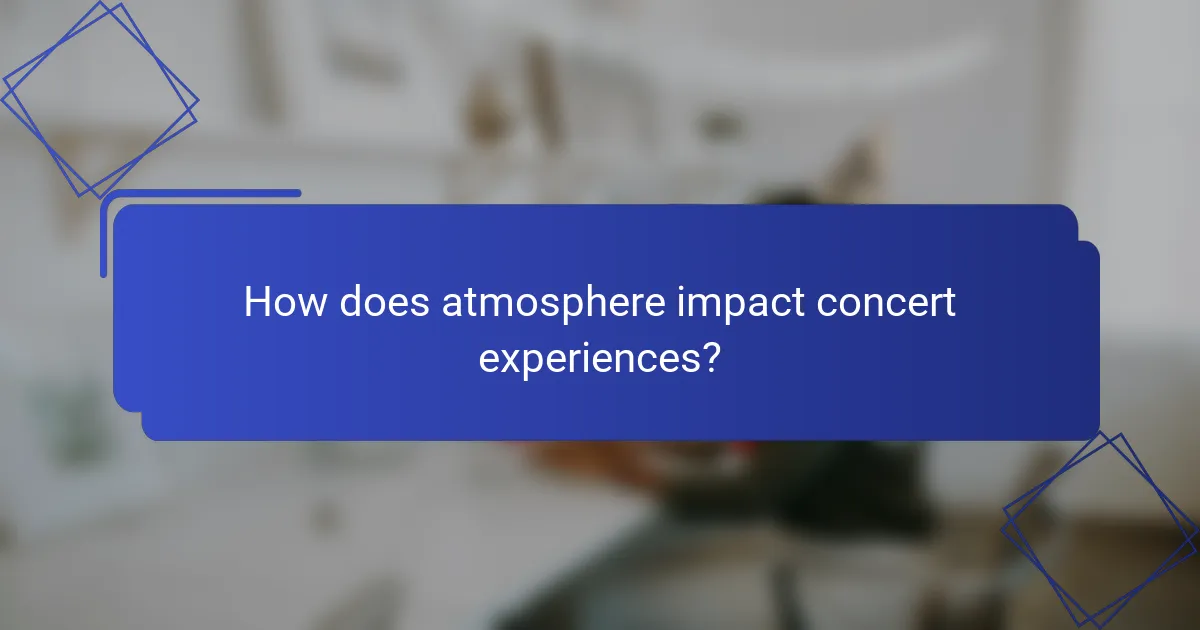
How does atmosphere impact concert experiences?
The atmosphere of a concert venue significantly influences the overall experience for attendees. Elements such as lighting, sound quality, and seating arrangements contribute to how the audience perceives the performance and engages with the music.
Lighting and visual effects
Effective lighting and visual effects can elevate a concert from a simple performance to a captivating experience. Dynamic lighting that syncs with the music can enhance emotional responses and create memorable moments. Venues often use a combination of spotlights, colored lights, and projections to create a unique ambiance.
When selecting a venue, consider how the lighting setup complements the type of music being performed. For example, electronic music often benefits from vibrant, fast-paced lighting, while acoustic performances may favor softer, more subdued lighting. Check if the venue has the necessary equipment and expertise to deliver the desired visual effects.
Seating arrangements and comfort
Seating arrangements play a crucial role in how comfortably attendees can enjoy a concert. Venues should provide adequate space between seats to allow for movement and comfort, especially during longer performances. General admission areas can foster a lively atmosphere but may lead to overcrowding, while assigned seating can enhance comfort but limit interaction.
When evaluating a venue, consider the layout and how it affects sightlines and acoustics. Venues with tiered seating often provide better views of the stage, while those with more intimate layouts can create a closer connection between the audience and performers. Always check for accessibility options to accommodate all attendees, ensuring everyone can enjoy the concert experience fully.

What accessibility features should concert venues have?
Concert venues should have a range of accessibility features to accommodate individuals with disabilities. Key elements include wheelchair access, designated seating, and transportation options that facilitate easy entry and exit.
Wheelchair access and seating
Wheelchair access is crucial for ensuring that all attendees can enjoy the concert experience. Venues should have ramps, elevators, and wide doorways to allow easy entry. Additionally, designated seating areas should be available, ideally located for optimal viewing and comfort.
When selecting a venue, check for the availability of companion seating next to wheelchair spots, as this enhances the experience for those attending with friends or family. It’s also beneficial to confirm that the venue complies with local accessibility regulations, which often dictate minimum requirements for seating and access.
Transportation options and parking
Accessible transportation options are essential for concertgoers with disabilities. Venues should be located near public transport that offers accessible services, such as buses and trains with low floors or ramps. Additionally, venues should provide clear information on accessible routes to reach the venue from these transport points.
Parking is another critical aspect; venues should offer designated accessible parking spaces close to the entrance. It’s advisable to check if these spots require advance booking or if they are available on a first-come, first-served basis. Always verify the venue’s parking policies to avoid any last-minute issues on concert day.

How do concert venues in Los Angeles compare?
Concert venues in Los Angeles vary widely in size, atmosphere, and accessibility, impacting the overall experience for attendees. Factors such as location, seating capacity, and amenities play a crucial role in how these venues cater to different audiences.
Popular venues and their attributes
Los Angeles boasts several iconic concert venues, each with unique characteristics. The Hollywood Bowl, known for its stunning outdoor setting and natural acoustics, accommodates around 17,000 guests and hosts a diverse range of performances from classical to contemporary music.
The Staples Center, a multi-purpose arena, offers a more urban experience with a capacity of approximately 19,000. It is home to major sporting events and concerts, featuring state-of-the-art technology and amenities. Smaller venues like The Troubadour provide an intimate atmosphere, allowing fans to connect closely with artists in a setting that holds about 500 people.
Differences in audience demographics
Audience demographics at concert venues in Los Angeles can differ significantly based on the venue’s size and genre of music. Larger venues like the Staples Center tend to attract a more diverse crowd, including fans from various age groups and backgrounds, drawn by big-name artists and mainstream music.
In contrast, smaller venues such as The Echo often cater to niche audiences, attracting younger crowds interested in indie and alternative music. These venues foster a sense of community, where attendees share a common passion for emerging artists and genres.
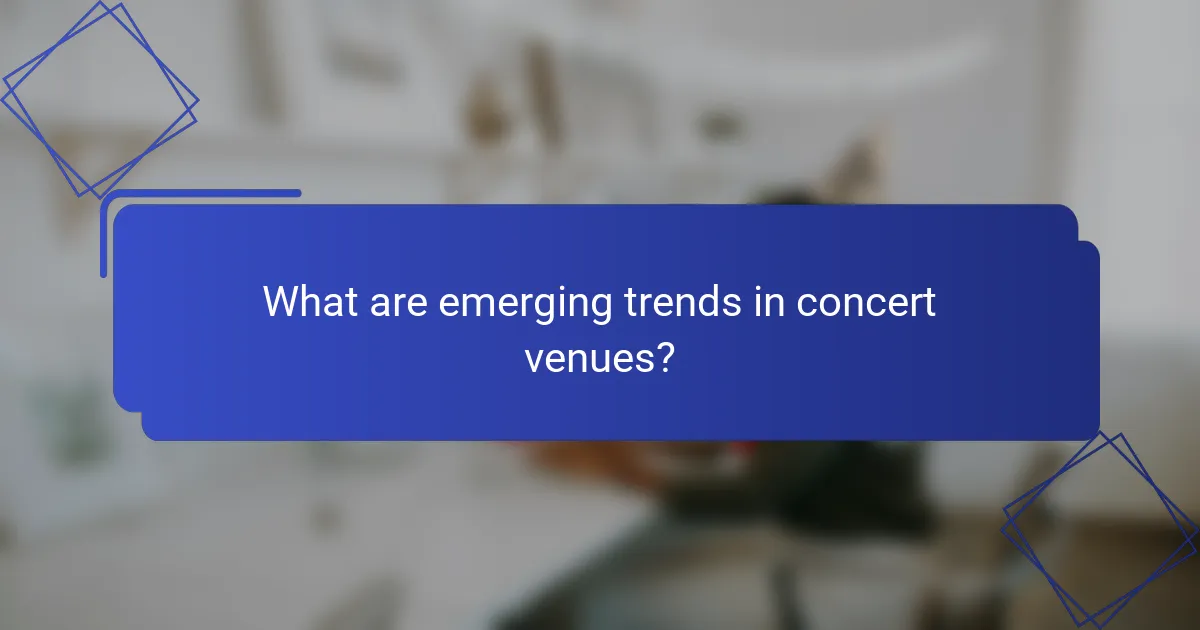
What are emerging trends in concert venues?
Emerging trends in concert venues focus on enhancing the audience experience through technology and sustainability. Venues are increasingly adopting innovative solutions to improve engagement and reduce their environmental impact.
Integration of technology in live events
The integration of technology in live events enhances both the performance and audience interaction. Venues are utilizing advanced sound systems, high-definition video screens, and augmented reality to create immersive experiences.
For example, some venues now offer mobile apps that allow attendees to order food and drinks directly from their seats, minimizing wait times. Additionally, live streaming options are becoming more common, enabling fans to participate remotely.
Sustainability practices in venue management
Sustainability practices in venue management are gaining traction as venues aim to reduce their carbon footprint. This includes using energy-efficient lighting, implementing waste reduction programs, and sourcing local products for concessions.
Many venues are also pursuing certifications such as LEED (Leadership in Energy and Environmental Design) to demonstrate their commitment to eco-friendly practices. For instance, some have adopted solar panels to power their operations, significantly lowering energy costs and environmental impact.

